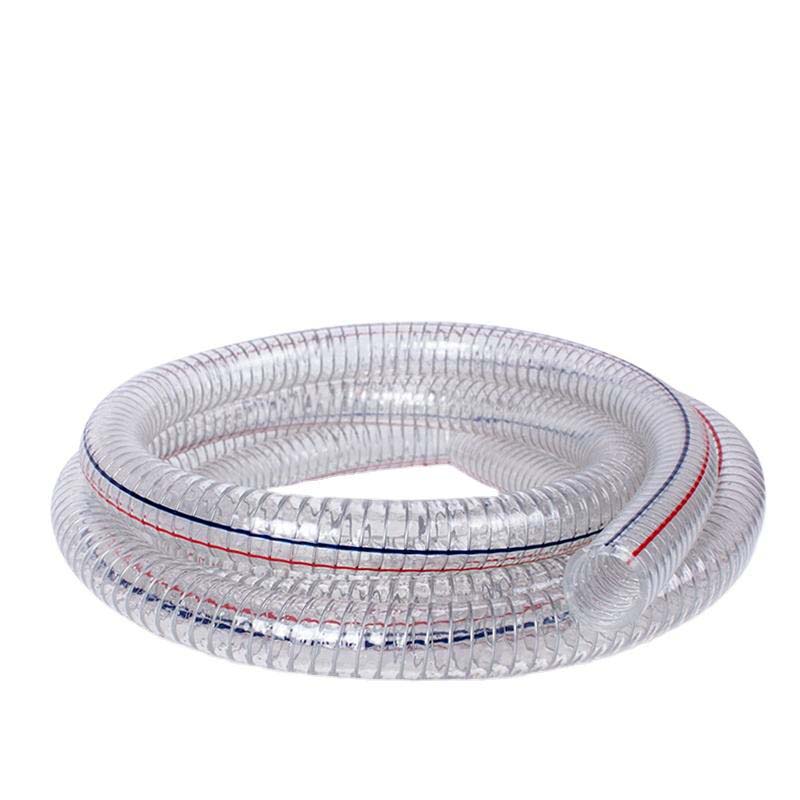Jun . 11, 2024 19:21
Back to list
Oxy-acetylene welding hose is essential.
Oxy-acetylene welding is a versatile and powerful method of metal joining that utilizes the combustion of acetylene gas in pure oxygen to produce an intensely hot flame, capable of melting even the most refractory metals. At the heart of this process lies the oxy-acetylene welding hose, a critical component that ensures the safe and efficient delivery of these gases to the welding torch.
The oxy-acetylene welding hose is specially designed to carry both oxygen and acetylene, often through separate tubes within a single hose assembly. These tubes are color-coded for safety; oxygen hoses are typically green, while acetylene hoses are red, helping users easily distinguish between the two gases and reducing the risk of dangerous misconnections.
Manufactured from high-quality materials such as polyvinyl chloride (PVC) or rubber, these hoses are flexible yet durable, withstanding the pressures and temperatures inherent in welding operations. They are also resistant to oils, grease, and other chemicals that might be present in a workshop environment, ensuring they maintain their integrity over time.
Proper maintenance of the oxy-acetylene welding hose is crucial for safe operation. This includes regular visual inspections for signs of wear, damage, or leaks. Hoses should be stored carefully when not in use, avoiding sharp bends or kinks that could damage the internal lining. Additionally, it's essential to follow the manufacturer's guidelines for replacement intervals based on usage and environmental conditions.
Safety standards dictate that oxy-acetylene welding hoses must comply with specific performance criteria
Safety standards dictate that oxy-acetylene welding hoses must comply with specific performance criteriaoxy acetylene welding hose. For instance, they must be able to withstand a certain pressure without bursting or leaking . Moreover, they should be compatible with various fittings and regulators used in oxy-acetylene welding setups.
Innovations in hose design have led to improvements in efficiency and safety. Some advanced hoses feature layers of braided fibers or wire mesh that provide additional protection against cuts and abrasions. Others may have enhanced thermal resistance, allowing them to operate in higher temperature environments without degradation.
Environmental considerations are also becoming increasingly important in the manufacturing and disposal of oxy-acetylene welding hoses. Eco-friendly materials and recycling programs aim to reduce the environmental impact of these products throughout their lifecycle.
The oxy-acetylene welding hose is a testament to the meticulous engineering required for industrial applications. It embodies a blend of safety, durability, and efficiency that is vital for successful welding outcomes. As technology continues to evolve, so too will the design and functionality of these essential components, further enhancing the field of oxy-acetylene welding and pushing the boundaries of what can be achieved with this powerful technique.
. Moreover, they should be compatible with various fittings and regulators used in oxy-acetylene welding setups.
Innovations in hose design have led to improvements in efficiency and safety. Some advanced hoses feature layers of braided fibers or wire mesh that provide additional protection against cuts and abrasions. Others may have enhanced thermal resistance, allowing them to operate in higher temperature environments without degradation.
Environmental considerations are also becoming increasingly important in the manufacturing and disposal of oxy-acetylene welding hoses. Eco-friendly materials and recycling programs aim to reduce the environmental impact of these products throughout their lifecycle.
The oxy-acetylene welding hose is a testament to the meticulous engineering required for industrial applications. It embodies a blend of safety, durability, and efficiency that is vital for successful welding outcomes. As technology continues to evolve, so too will the design and functionality of these essential components, further enhancing the field of oxy-acetylene welding and pushing the boundaries of what can be achieved with this powerful technique.
 . Moreover, they should be compatible with various fittings and regulators used in oxy-acetylene welding setups.
Innovations in hose design have led to improvements in efficiency and safety. Some advanced hoses feature layers of braided fibers or wire mesh that provide additional protection against cuts and abrasions. Others may have enhanced thermal resistance, allowing them to operate in higher temperature environments without degradation.
Environmental considerations are also becoming increasingly important in the manufacturing and disposal of oxy-acetylene welding hoses. Eco-friendly materials and recycling programs aim to reduce the environmental impact of these products throughout their lifecycle.
The oxy-acetylene welding hose is a testament to the meticulous engineering required for industrial applications. It embodies a blend of safety, durability, and efficiency that is vital for successful welding outcomes. As technology continues to evolve, so too will the design and functionality of these essential components, further enhancing the field of oxy-acetylene welding and pushing the boundaries of what can be achieved with this powerful technique.
. Moreover, they should be compatible with various fittings and regulators used in oxy-acetylene welding setups.
Innovations in hose design have led to improvements in efficiency and safety. Some advanced hoses feature layers of braided fibers or wire mesh that provide additional protection against cuts and abrasions. Others may have enhanced thermal resistance, allowing them to operate in higher temperature environments without degradation.
Environmental considerations are also becoming increasingly important in the manufacturing and disposal of oxy-acetylene welding hoses. Eco-friendly materials and recycling programs aim to reduce the environmental impact of these products throughout their lifecycle.
The oxy-acetylene welding hose is a testament to the meticulous engineering required for industrial applications. It embodies a blend of safety, durability, and efficiency that is vital for successful welding outcomes. As technology continues to evolve, so too will the design and functionality of these essential components, further enhancing the field of oxy-acetylene welding and pushing the boundaries of what can be achieved with this powerful technique. Latest news
-
Unrivaled Performance and Applications of PU Pneumatic Hoses and TubesNewsJun.11,2025
-
The Transparent World of Industrial Tubing and Hosing SolutionsNewsJun.11,2025
-
The Intricate World of Pneumatic Conduits: Tubes and HosesNewsJun.11,2025
-
The Dynamic Landscape of Pneumatic Conduits: Unraveling Key ComponentsNewsJun.11,2025
-
The Diverse Applications and Significance of Transparent PVC TubingNewsJun.11,2025
-
High - Pressure Pneumatic Tubing and Systems: An In - Depth LookNewsJun.11,2025
HOT PRODUCT
Provide You The Highest Quality Work
INQUIRE














